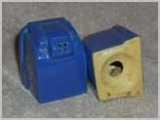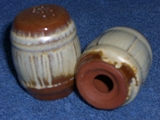


Dutch Shoe Shakers:
915H:1957-1959
The Dutch shoe design seems very out of place along with all the Indians, cowboys, and other western motifs common to Frankoma. As you might guess a good story lurks in the background.
About 1957 a young man from Holland named Johnny arrived in Oklahoma. He convinced John Frank that they both could become rich selling a line of Dutch shoe items designed and manufactured by Frankoma. Johnny (the last name is lost) was to be the salesman but his efforts failed. He soon disappeared from the scene leaving John Frank with the marketing task and a fresh supply of stock. Frank's sales effort failed too and the line was soon dropped.*
The design group includes a 9” wall pocket, a 9” planter, a 6” and 4” ashtray, a pair of 6” shoes, a pair of 4” shoes on a thong, and the salt and pepper shakers. As one might expect, with as little as two years of production the value of the Dutch shoe shakers is quite high. This is one of the most difficult of the recent issues to collect. In fact, only the Trade Winds Tiki’s and a handful of the older issues are harder to find than a pair of Dutch shoe shakers!
Dutch shoe items first appeared in the 1958 catalog but some have glazes not in use after 1957. They were again in the 1959 catalog but were absent from the 1960 catalog. The 1957 introduction date is based on available 1957 glazes (desert rose, turquoise). While Frankoma may have had some stock left over in 1960 these items appear only in the 1958 and 1959 catalog.
The years 1957 to 1959 saw only brick red clay and American rutile glazes so the colors and contrasts on these will almost always be outstanding. The design is durable so damage is not much of a problem to the collector. These usually bear the mark “915H” on the heel. Frankoma placed the mold number in the production mold, not the master mold. Consequently several slightly different marks exist. I believe these are the only shakers with a base mark or inscription of any kind made after about 1943.
These should be available in nine different glazes: prairie green, desert gold, brown satin, white sand, onyx black, clay blue, sunflower yellow, turquoise and terra cotta rose.** Most of the examples will be in prairie green. Until about 2001 Dutch shoe items were not commonly believed to exist in turquoise and terra cotta rose but both have now been confirmed. Other than the eight glazes represented here I also know of a pair in turquoise. The glaze woodland moss is also a remote possibility as it came into production near the end of Dutch shoe production.
Some early Dutch shoe items are marked on the base “To Johnny from Holland” but I know of no shakers with this inscription. These were from the first production (while Johnny was still around) and possibly were made with turquoise or terra cotta rose glaze. What a find that would be!








